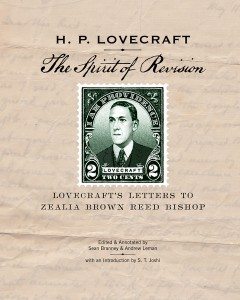
Edited by Sean Branney and Andrew Leman
The H. P. Lovecraft Historical Society
2015
Reviewed by David Goudsward
In 2014, the holiest of holies in Lovecraftian scholarship was heralded— an unknown cache of Lovecraft’s letters was found. Thirty-six new letters from the Old Gent of Providence to Zealia Brown Reed Bishop were discovered in an old trunk in a basement by her great-great nephew.
The H.P. Lovecraft Historical Society has painstakingly transcribed the original letters, dating from 1927 to 1936, and collated them with eighteen previously catalogued letters. The result is not a complete collection of their correspondence, but it may be the most complete series of letters focusing on Lovecraft’s ghostwriting occupation.
The letters start out as formal business correspondence between the fledgling authoress and Lovecraft, the hired revisionist. As the letters progress across the decade, the relationship evolves into a friendship, with Bishop sending a steady stream of short stories for revision even as the two struggle over the direction of her prose. Along the way, readers gain insight into how Lovecraft ran his editing services as the relationship evolves into more of a mentor/protégé (at least in Lovecraft’s mind), and then collaborator, essentially rewriting Bishop’s most well-known stories “The Curse of Yig,” “The Mound,” and “Medusa’s Coil.”
The collection is extensively annotated by Branney and Leman and includes images of various reference pamphlets, newspaper clippings, and magazines recommendations sent from Providence. The result is a very readable aspect of Lovecraft explaining his vision of how a story should be written.
The H. P. Lovecraft Historical Society is a company more noted for frivolous products such as t-shirts, prop documents for RPGs, and radio and film adaptations of stories. And although I love a Miskatonic University coffee mug or Innsmouth Swim Team tee as much as the next guy, this book is a shift in the paradigm for the HPLHS, and I applaud this major contribution to scholarship.








